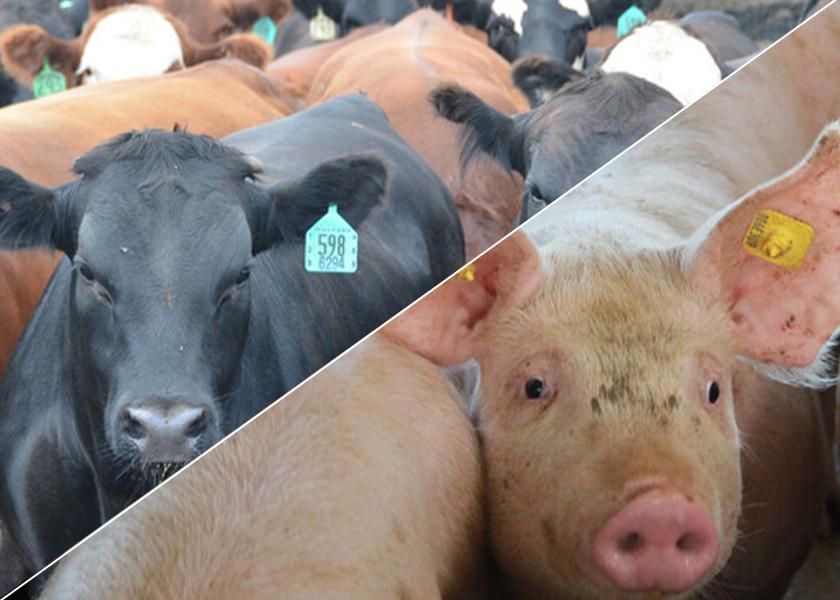Livestock Analysis | January 5, 2021

Price action: February lean hogs surged $2.125 to $82.275, while April jumped $1.675 to $88.675, the contract’s highest close since Oct. 1.
Fundamental analysis: Hog futures climbed on strengthening cash fundamentals. Packer reporting problems delayed the release of data used to calculate the CME lean hog index, leading to a belated rally today. The next index is expected to be $73.87, an increase of $1.92 over the previous two sessions and the highest since mid-November.
Pork belly primal values soared over $27 this morning, which, combined with sizeable gains in most other cuts, boosted the early pork cutout average by $7.77 to $91.32. As is often the case, the afternoon pork cutout quote will probably come in below the early reading, as most buyers refrain from chasing the wholesale market higher.
We still expect this week’s kill to easily top the mid-December high at 2.653 million head, due entirely to two consecutive weeks of packer cutbacks over the year-end holidays. However, we are also anticipating slaughter rates over the next two months to fall 6.0% under year-ago levels, as implied by the December 23 USDA Hogs & Pigs report. Anticipation of those cutbacks and their likely amplification of the usual early-year rally has been powering the sizeable premium already built into the nearby contracts. Those could begin looking much too high if surging Covid infections cause major packing plant slowdowns or shutdowns, but we suspect packers will deal with the situation much better than they did in spring 2020.
Technical analysis: Today’s rally returned the technical advantage in February hogs to the bullish camp, especially with the surge crushing resistance at the contract’s 20- and 40-day moving averages near $81.14 and $81.12, respectively. Those now mark initial support. Look for additional support at yesterday’s low of $80.00, then at the December 8 low of $75.35. Bulls couldn’t force a close above the 10-day moving average at $82.453, which now represents initial resistance. A push above that level would again have bulls targeting December 27 high at $84.65, then the October 1 peak at $87.475.
What to do: Get current with feed advice.
Hedgers: You currently have all risk in the cash market.
Feed needs: You are hand-to-mouth on corn-for-feed and soybean meal needs. Wait on price pullbacks to extend coverage.
Price action: February live cattle fell 57.5 cents to $137.25, the contract’s lowest settlement since $136.925 on Dec. 21. March feeder cattle fell 17.5 cents to $166.175.
Fundamental analysis: Live cattle futures continued a recent slide, closing at a two-week low, amid mixed signals from cash and wholesale beef markets. USDA reports yesterday indicated some live steers sold for around $139.47, down modestly from last week. Later today, sources indicated a few animals had traded at $220 dressed and $138 live in the Southern Plains, which would be down $1.00 to $2.00 from last week. Recent futures weakness likely contributed to the cash market erosion, but feedlot operators likely won’t cut asking prices significantly in the days ahead.
Given the cash market’s history of seasonal strength from December into April, the discount now built into the February contract is unusual, especially considering winter and early spring price strength stems largely from a seasonal cattle slaughter decline to annual lows through the first two months of the year. The steady, upward creep of wholesale beef prices also seems to presage improved packer bids in the near future. Choice cutout values rose another 65 cents early today to a four-week high at $267.47, while Select climbed $1.16 to $260.39.
Recent futures weakness may also reflect trader concern over a potential short-term repeat of the spring 2020 packing plant shutdowns forced by widespread Covid infections. These concerns are likely overblown, but can’t be ruled out completely.
Technical analysis: Bears hold the technical advantage, especially after February live cattle failed at 40-day moving average resistance around $138.20 in early trading, then moved moderately lower. Additional overhead resistance is likely marked by the 10-day moving average near $139.00, but a push above that level would have bulls targeting last week’s high at $141.425. Look for initial support at yesterday’s low of $136.775, then at the Dec. 20 low of $135.50. A drop below that level would have bears looking to test the October 22 low of $133.40.
What to do: Short-term protective hedges for fed cattle producers may be needed if recent lows are violated.
Hedgers: Carry all risk in the cash market for now.
Feed needs: You are hand-to-mouth on corn-for-feed and soybean meal needs. Wait on price pullbacks to extend coverage.






